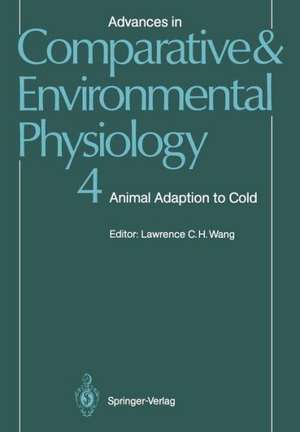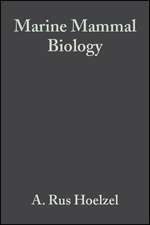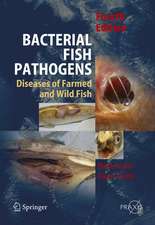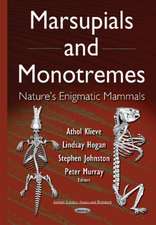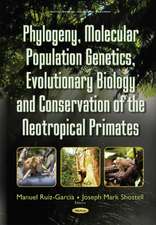Advances in Comparative and Environmental Physiology: Animal Adaptation to Cold: Advances in Comparative and Environmental Physiology, cartea 4
Editat de Lawrence C.H. Wang Contribuţii de J.A. Boulant, R.J. Brooks, M.C. Curras, T.J. Dawson, W.R. Dawson, J.B. Dean, D.D. Feist, D.A. Galbraith, J.R. Hazel, B.A. Horwitz, D.M. Lavigne, T.-F. Lee, R.A. MacArthur, R.L. Marsh, R.D. Myers, D.A. Rosen, J.M. Storey, K. B. Storey, L.C.H. Wang, R.G. Whiteen Limba Engleză Paperback – 6 dec 2011
Din seria Advances in Comparative and Environmental Physiology
- 15%
 Preț: 644.63 lei
Preț: 644.63 lei - 15%
 Preț: 643.99 lei
Preț: 643.99 lei - 18%
 Preț: 1384.56 lei
Preț: 1384.56 lei - 15%
 Preț: 639.59 lei
Preț: 639.59 lei - 5%
 Preț: 725.79 lei
Preț: 725.79 lei - 15%
 Preț: 641.85 lei
Preț: 641.85 lei - 15%
 Preț: 634.68 lei
Preț: 634.68 lei - 15%
 Preț: 639.25 lei
Preț: 639.25 lei - 15%
 Preț: 638.76 lei
Preț: 638.76 lei -
 Preț: 392.75 lei
Preț: 392.75 lei - 15%
 Preț: 588.65 lei
Preț: 588.65 lei - 15%
 Preț: 639.73 lei
Preț: 639.73 lei - 15%
 Preț: 640.71 lei
Preț: 640.71 lei - 15%
 Preț: 641.38 lei
Preț: 641.38 lei - 15%
 Preț: 639.08 lei
Preț: 639.08 lei - 15%
 Preț: 640.06 lei
Preț: 640.06 lei - 5%
 Preț: 712.46 lei
Preț: 712.46 lei - 5%
 Preț: 1092.99 lei
Preț: 1092.99 lei - 15%
 Preț: 646.94 lei
Preț: 646.94 lei - 15%
 Preț: 640.06 lei
Preț: 640.06 lei - 15%
 Preț: 649.71 lei
Preț: 649.71 lei - 15%
 Preț: 638.57 lei
Preț: 638.57 lei - 15%
 Preț: 634.49 lei
Preț: 634.49 lei - 15%
 Preț: 640.71 lei
Preț: 640.71 lei
Preț: 651.34 lei
Preț vechi: 766.28 lei
-15% Nou
Puncte Express: 977
Preț estimativ în valută:
124.65€ • 135.35$ • 104.70£
124.65€ • 135.35$ • 104.70£
Carte tipărită la comandă
Livrare economică 22 aprilie-06 mai
Preluare comenzi: 021 569.72.76
Specificații
ISBN-13: 9783642740800
ISBN-10: 3642740804
Pagini: 456
Ilustrații: XIII, 441 p.
Dimensiuni: 170 x 244 x 24 mm
Greutate: 0.72 kg
Ediția:Softcover reprint of the original 1st ed. 1989
Editura: Springer Berlin, Heidelberg
Colecția Springer
Seria Advances in Comparative and Environmental Physiology
Locul publicării:Berlin, Heidelberg, Germany
ISBN-10: 3642740804
Pagini: 456
Ilustrații: XIII, 441 p.
Dimensiuni: 170 x 244 x 24 mm
Greutate: 0.72 kg
Ediția:Softcover reprint of the original 1st ed. 1989
Editura: Springer Berlin, Heidelberg
Colecția Springer
Seria Advances in Comparative and Environmental Physiology
Locul publicării:Berlin, Heidelberg, Germany
Public țintă
ResearchCuprins
1 Cold Adaptation in Ectotherms: Regulation of Membrane Function and Cellular Metabolism.- 1 Introduction.- 2 Homeoviscous Adaptation to Temperature in Ecotherms.- 3 Adaptations in the Rates and Patterns of Cellular Energy Metabolism.- 4 Conclusions.- References.- 2 Freeze Tolerance and Freeze Avoidance in Ectotherms.- 1 Introduction.- 2 Low Temperature and Freezing.- 3 Freeze Avoidance.- 4 Freeze Tolerance.- 5 The Choice of Freeze Tolerance Versus Freeze Avoidance.- References.- 3 Biochemical Mechanisms and Control of Cold-Induced Cellular Thermogenesis in Placental Mammals.- 1 Introduction.- 2 “Categories” of Thermogenesis.- 3 Acute Cold Exposure.- 4 Sustained Cold Exposure.- 5 Seasonal Changes in NST Capacity.- 6 Conclusion.- References.- 4 Neurophysiological Aspects of Thermoregulation.- 1 Introduction.- 2 Whole Body Thermoregulatory Responses.- 3 Sensitivity of Neurons Involved in Temperature Regulation.- 4 Neuronal Integration of Central and Peripheral Thermal Signals.- 5 Role of Afferent Input in Determining Neuronal Populations.- 6 Neural Mechanisms of Cold Adaptation.- References.- 5 Neurochemical Aspects of Thermoregulation.- 1 Introduction.- 2 Catecholamines.- 3 Indole Amines.- 4 Acetylcholine.- 5 Histamine.- 6 Peptides.- 7 Cations.- 8 Conclusion.- References.- 6 Avian Adjustments to Cold.- 1 General Introduction.- 2 Avian Body Temperature (Tb) and its Control.- 3 Thermogenic Responses.- 4 Substrate Metabolism in the Cold.- 5 Control of Thermolysis.- 6 Summary and Perspective.- References.- 7 Responses to Cold of Monotremes and Marsupials.- 1 Historical Perspective.- 2 Monotremes in the Cold.- 3 Marsupials in the Cold.- 4 Insights into the Evolution of Homeothermy?.- References.- 8 Aquatic Mammals in Cold.- 1 Introduction.- 2 Diversity of AquaticMammals.- 3 Thermal Challenges of the Aquatic Medium.- 4 Thermoregulatory Performance of Aquatic Mammals.- 5 Temperature Regulation Tactics.- 6 Summary and Conclusions.- References.- 9 Terrestrial Mammals in Cold.- 1 Introduction.- 2 Basal Metabolic Rate.- 3 Thermal Conductance and Insulation.- 4 Peripheral Heterothermy.- 5 Heat Production.- 6 Adaptations of Humans to Cold.- 7 Conclusions.- References.- 10 Ecological, Physiological, and Biochemical Aspects of Torpor in Mammals and Birds.- 1 Introduction.- 2 Physiological Manifestations in a Torpor Bout.- 3 Energetics of Torpor.- 4 Physiological and Biochemical Adaptations.- 5 Summary.- References.- 11 Cold, Energetics, and Populations.- 1 Introduction.- 2 Distribution Patterns.- 3 Abundance.- 4 Energy Budgets and Population Parameters.- 5 Summary and Conclusions.- References.
